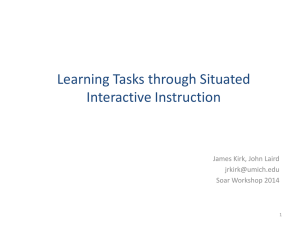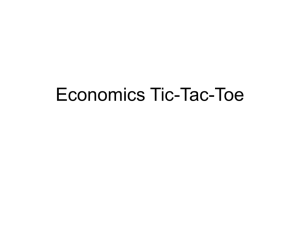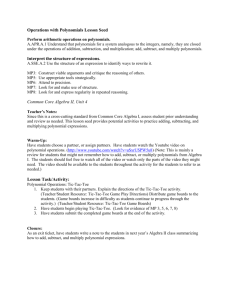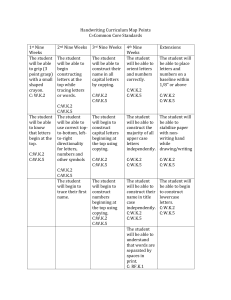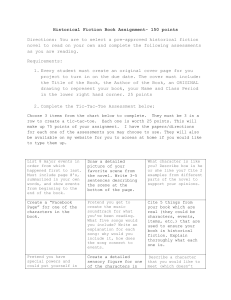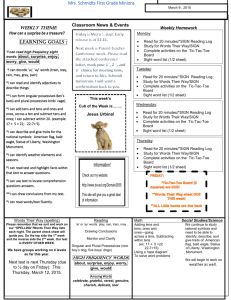A Tinkertoy Computer that plays tic-tac-toe
advertisement
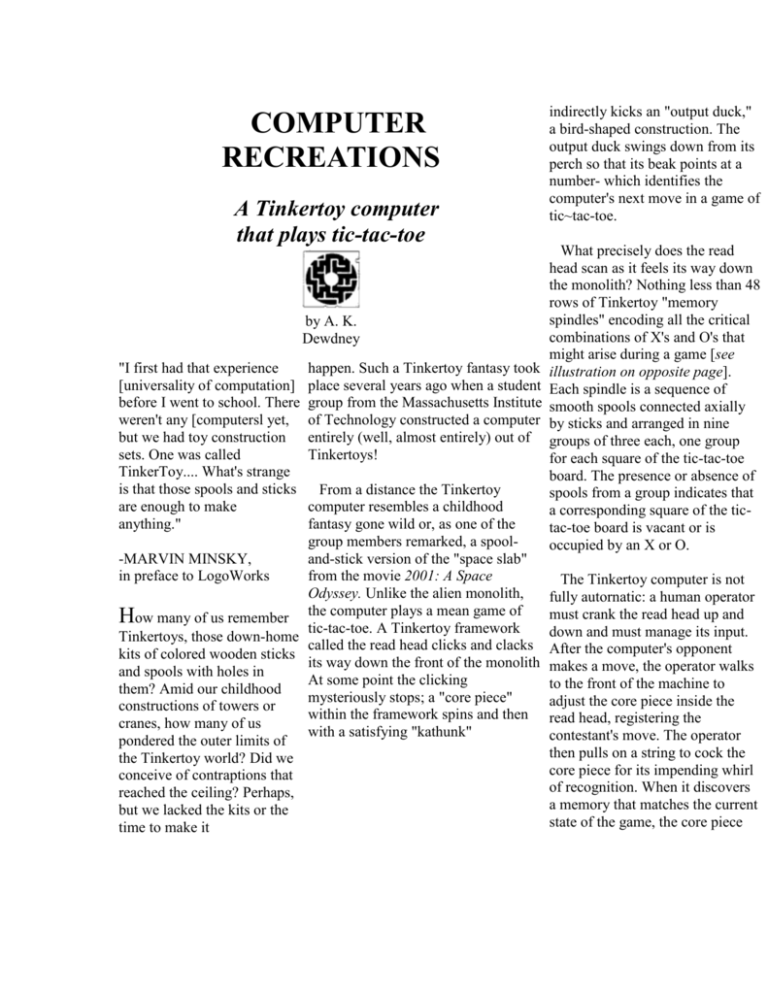
COMPUTER RECREATIONS A Tinkertoy computer that plays tic-tac-toe by A. K. Dewdney "I first had that experience [universality of computation] before I went to school. There weren't any [computersl yet, but we had toy construction sets. One was called TinkerToy.... What's strange is that those spools and sticks are enough to make anything." happen. Such a Tinkertoy fantasy took place several years ago when a student group from the Massachusetts Institute of Technology constructed a computer entirely (well, almost entirely) out of Tinkertoys! From a distance the Tinkertoy computer resembles a childhood fantasy gone wild or, as one of the group members remarked, a spool-MARVIN MINSKY, and-stick version of the "space slab" in preface to LogoWorks from the movie 2001: A Space Odyssey. Unlike the alien monolith, computer plays a mean game of How many of us remember the tic-tac-toe. A Tinkertoy framework Tinkertoys, those down-home called the read head clicks and clacks kits of colored wooden sticks its way down the front of the monolith and spools with holes in At some point the clicking them? Amid our childhood mysteriously stops; a "core piece" constructions of towers or within the framework spins and then cranes, how many of us with a satisfying "kathunk" pondered the outer limits of the Tinkertoy world? Did we conceive of contraptions that reached the ceiling? Perhaps, but we lacked the kits or the time to make it indirectly kicks an "output duck," a bird-shaped construction. The output duck swings down from its perch so that its beak points at a number- which identifies the computer's next move in a game of tic~tac-toe. What precisely does the read head scan as it feels its way down the monolith? Nothing less than 48 rows of Tinkertoy "memory spindles" encoding all the critical combinations of X's and O's that might arise during a game [see illustration on opposite page]. Each spindle is a sequence of smooth spools connected axially by sticks and arranged in nine groups of three each, one group for each square of the tic-tac-toe board. The presence or absence of spools from a group indicates that a corresponding square of the tictac-toe board is vacant or is occupied by an X or O. The Tinkertoy computer is not fully autornatic: a human operator must crank the read head up and down and must manage its input. After the computer's opponent makes a move, the operator walks to the front of the machine to adjust the core piece inside the read head, registering the contestant's move. The operator then pulls on a string to cock the core piece for its impending whirl of recognition. When it discovers a memory that matches the current state of the game, the core piece spins, and the computer indicates its move. The best way to understand how the machine works in detail is to recount the story of its creation at the hands of the M.I.T. students: Erlyne Gee, Edward Hardebeck, Daniel Hillis, Margaret Minsky and brothers Barry and Brian Silverman. Most of the group has long since graduated and entered various computer professions. Perhaps the best-known team member is Hillis. He was the moving force behind Thinking Machines, Inc., which produces the well-known parallel supercomputer called the Connection Machine. (Perhaps Tinkertoys have something to teach us.) The first three levels of the tic-tac-toe game tree 120 SCIENTIFIC AMERICAN October 1989 In 1975, when Hillis and Brian Silverman were in their sophomore year, they participated in a class project to build something digital from Tinkertoys. The students sat down to play. One made an invertera logic device that converts a binary 1 signal to a 0 signal and conversely. Another made an OR gate; if either of the device's two input signals happened to be a 1, then its output would also be a 1. It quickly became clear to the students that Tinkertoys were "computation universal," the theoretical term for a set of components from which a fully program mable computer can be constructed. Theoretical possibility was one thing, the practical demands of money and time another. The demands were met in a rather roundabout manner through Hillis's interest in robots. From time to time he had mused openly about building a robot. Word of his idea somehow reached the ear of Harry Loucks, then director of the Mid-America Center in Hot Springs, Ark. Would the students like to construct a robot as a display in the center's museum? The students agreed in principle, but the project seemed too complicated. Just then the old Tinkertoy dream resurfaced. WouId the center like a computer made out of Tinkertoys instead? Hillis and company set out to assemble the first Tinkertoy computer in a laboratory at M.I.T. The first model, unlike its successor, was a bulky cube with sides about one meter long. It was impressively complicated. Packed with logic devices made entirely of wooden sticks and spools, the machine signaled its moves by waving nine flags from the top of the framework. The prototype Tinkertoy computer had to be taken apart for the trip to Hot Springs, and once it was reassembled on site, the machine never quite worked properly again. On the other hand, it did make an intriguing exhibit. (It is currently on display at the Computer Museum in Boston.) In 1979 Loucks contacted the group again. Could they make a new Tinkertoy computer, one that worked? By this time Silverman was in Ottawa and Hillis in Boston, each pursuing a new career. Over the telephone Hillis and Silverman worked out an improved design. It was to be reliable, and that meant simple. They decided to lay out all the possible tictac-toe boards in a row and devise some kind of reading mechanism that would move from row to row until it found a pattern matching the current board. The very act of recognition could trigger a preset response. While Hillis contemplated ways to represent tic-tactoe boards with digital Tinkertoy components, Silverman analyzed the game. To appreciate the complexities involved even in this childhood pastime, readers might consult the game tree shown on the opposite page. In the middle of the tree sits the initial board, a three-by-three grid empty of X's and O's. From this initial board nine new ones can arise, depending on which of the nine squares X plays. The figure shows just three possibilities; the remaining six are rotated versions. Each of the three 121 SCIENTIFIC AMERICAN October 1989 boards at the second level gives rise to other cases. For example, the board in which X plays the center square and then another square results in two different boards. The other two boards at the second level each generate five new boards at the third level. I pruned many branches from the tic-tac-toe tree by appealing to a symmetry argument: the excluded boards are merely rotations or reflections of the included ones. Symmetry seems simple to humans, but a computer must be programmed or wired to recognize it. In a world of Tinkertoy engineering, symmetry operations would require elaborate structures. Silverman was dealing with a tree, therefore, that was many times larger than the fragment shown in the illustration. But perseverance paid off, especially when Silverman employed a computer program that analyzed the game of tic-tac-toe and discovered that a great many boards could be collapsed into one by a forced move. Suppose, for example, that two squares in a row contain O's and the third is blank. The their spool-and-stick odyssey: 30 boxes of Tinkertoys, each containing 250 pieces. Some team members put together the supporting framework that would hold all 48 memory spindles. To explain precisely how the spindles were made, I must digress for a moment and describe the conventions employed by the team to encode tic-tac-toe positions. along the axis of the core piece into any of three possible positions: one for X, one for O and one for blank. The core piece could therefore store any possible tic-tac-toe board by virtue of the positions of its nine fingers as moved by the operator for each play by human or machine. In the illustration below, fingers in the consecutive positions 2,1, 2, 3,1, 2, 2, 2, 2 would represent the board shown. First, the squares of a tic-tac-toe board were numbered as follows: If the current situation of play is stored in the core piece, does the Tinkertoy computer require any other memory? Could spool-andstick logic devices be strung 123 together to cogitate on the position 456 and ultimately to signal a move? 789 Well, yesbut such a Tinkertoy computer would be complicated Then a memory spindle was and immense. The memory divided conceptually into nine spindles eliminated the need for consecutive lengths in which most of the computer's cogitation. information about the status of each tic-tac-toe square was stored All the Tinkertoy computer had to do was to look up the current board from left to right. in the memory spindles. The only purpose of the search, naturally, Each length was further was to decide what move to make. subdivided into three equal sections, one for each possible A glance at the illustration on the item one might find in a square: preceding page makes it clear that an X, an O or a blank. Each each memory spindle was possibility was encoded by the contents of the remaining two rows are irrelevant since an opponent must fill the third square with an X or lose the game. lack of a spool. For example, if an X happened to occupy a certain square, the memory spindle would have no spool in the first position, one spool in the second and one spool in the third. Similarly, a spool missing in the second position denoted an unplayed square, and one missing in the third position symbolized an O. Finally, if all three spools were missing, it meant that what occupied the square was irrelevant. Silverman was delighted when he tallied up the final total of relevant boards: only 48. For each of them he noted the appropriate move by the machine. The surprisingly short list of possible board positions heartened Hillis. The group converged on Hot Springs, Silverman says, "with the list of 48 patterns and only a vague idea of how to interpret them One can hardly mention the mechanically." subject of memory spindles without bringing up the core piece, a thing of digital beauty. ( Readers who have a fanatical Here the Latin digitus came into bentor are stranded in airline terminalsmay enjoy working out its own, the construction the game tree on a few sheets of resembling a kind of rotating claw paper. How long does it take, after with nine fingers. The core piece all, to draw 48 tic-tac-toe patterns? and a sample memory spindle are shown in the illustration below. Four symbols should help sort things out X O, blank and a dash for "don't care.") The core piece consisted of nine equal sections. Each had its own finger, a short stick protruding Once settled in Hot Springs, the team assembled the raw material from the rim of a sliding spool. Within each section the finger for couid be moved accompanied by a number written on a paper strip hanging next to its output duck. These numbers were the machine's responses. As the read head clicks down the rows of spindles, the core piece wants to turn but cannot as long as at least one memory-spindle spool blocks one of the core piece's nine fingers. Only when the read head falls adjacent to the spindle that matches the current board do all nine fingers miss. Then the core piece whirls. By a mechanism that would do Rube Goldberg proud, a stick protruding from the end of the core piece engages another stick connected to the output duck. The spinning core piece thus kicks the duck off its perch to peck at a number writ large on the paper strip. Computer purists will ask whether the Tinkertoy contraption really deserves the title "computer." It is not, to A memory spindle, which encodes the X's and O's of a tic-tac-toe board, prevents the core piece from turning. 122 SCIENTIFIC AMERICAN October 1989 be sure, programmable in the usual sense: one cannot sit at a keyboard and type in a program for it to follow. On the other hand, one could certainly change the memory spindles, albeit with some difficulty, and thus reprogram the computer for other games. Imagine a Tinkertoy device that plays gomoku narabe (a game played on an 11-by-11 board in which one player tries to place five black stones in a row while preventing an opponent from creating a row of five white stones). A Tinkertoy computer programmed for go-moku narabe, however, would probably tower into the stratosphere. The real lesson the Tinkertoy computer can teach us resides in a rather amazing feature of digital computation: at the very root of a computation lies merely an essential flow of information. The computer hardware itself can take on many forms and designs. One could build perfectly accurate computers not only of Tinkertoys but also of bamboo poles, ropes and pulleys [see "Computer Recreations," SCIENTIFIC AMERICAN, April, 1988], plastic tubes and watereven, strange to think, electrical components. The lastnamed are preferred, of course, because of their speed. It would be shortsighted indeed to sneer at a computer made of Tinkertoys merely because it is not electronic. After all, even electrons and wires may not be the best materials for quick computer processing. Photons and fibers are gaining on them fast. Actually, Tinkertoys are well suited to digital computing. For example, the memory spindles use a binary principle: the presence or absence of spools denotes the status of a particular square on a tic-tac-toe board. The core piece exhibits digital logic: it can turn only if all its fingers miss corresponding spools on a memory spindle. Such an operation is called "and." One can trace the logic for the core piece in the illustration on the opposite page: if the first spool is absent from the first section of the memory spindle and the second spool is absent from the second section and the third spool is absent motive power to the awesome machine for its next move. Finally, the very joints of sticks and spools were made firm by glue and escutcheon pinspieces of hardware that commonly hold commemorative plaques in place. The team inserted the pins in holes drilled through the rim of the spool down to the original, central hole and through its sticka task they had to repeat more than 1,000 times. (When Hillis walked into a hardware store to obtain several thousand escutcheon pins, the manager looked bewildered. "We have," Hillis said with a straight face, "a lot of escutcheons.") The Tinkertoy tic-tac-toe computer suffered the fate of most museum exhibits. It was taken apart and crated. It sits in storage at the Mid-America Center, waiting to reemerge, perhaps, into the limelight. It may yet click its way to victory after victory, a monument to the Tinkertoy dreams of childhood. Well into my sixth year of "Computer Recreations," I am as painfully aware as ever that there are many things the department cannot do. It cannot, for example, teach readers how to program, nor can it mention the hundreds of fascinating programs and the many computer stories and ideas that readers send in, given the limitations of space and time. It took six years to discover a remedy to these and other needs: a newsletter. Its name is Algorithm: The Personal Programming Newsletter, and the first issue is now available. The newsletter will appear bimonthly. It seeks to pack a lot of information between its covers. In particular it will have two columns for people who like to program. One will be for beginners and the other for more experienced practitioners. A "bulletin board" at the back of the newsletter will make some of the world's underground programs public for the first time. Letters, stateof-the-art-icles and speculative pieces will aim to lead the mind into unexplored territory. I shall be delighted to send a free sample of the first issue to anyone who writes to me in care of Scientific American. FURTHER READING CHARLES BABBAGE: ON THE PRINCIPLES AND DEVELOPMENT OF THE CALCULATOR AND OTHER SEMINAL WRITINGS. Charles Babbage et al. Edited by Philip Morrison and Emily Morrison. Dover Publications, 1961. OPTICAL COMPUTING. Special issue edited by Sing H. Lee and Ravindra A. Athale in Optical Engineering, Vol. 28, No. 4; April, 1989. from the third section and so ononly if all nine conditions are met will the core piece turn. The beauty of the Tinkertoy computer is not just its clever mechanics but its subtle logic. Tinkertoy purists will be happy to know that the M.I.T. students stuck to the original wooden sticks and spools with only a few exceptions. An occasional aluminum rod runs through the framework to strengthen it. Two wire cables, an axle and a crank transmit 123 SCIENTIFIC AMERICAN October 1989 http://www.rci.rutgers.edu/~cfs/472_html/Intro/IntroToc.html
